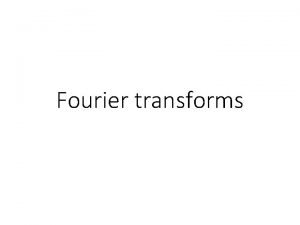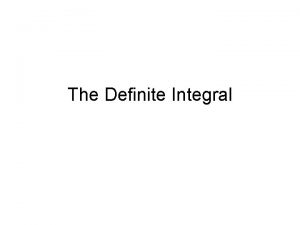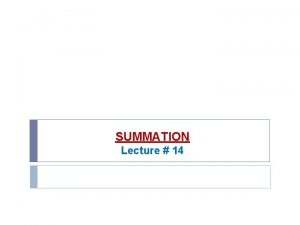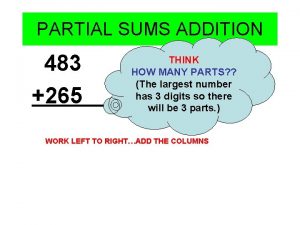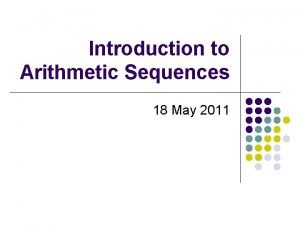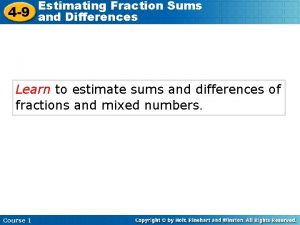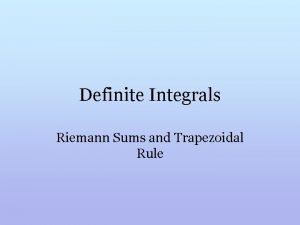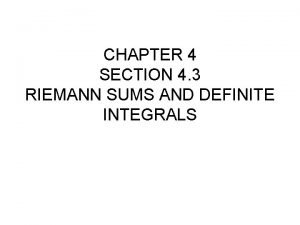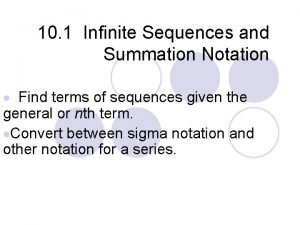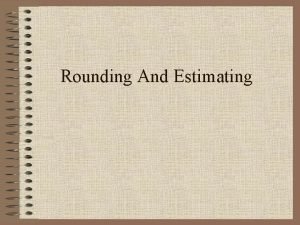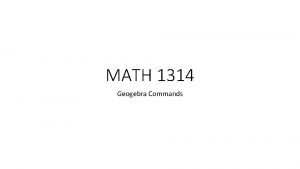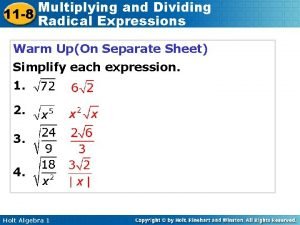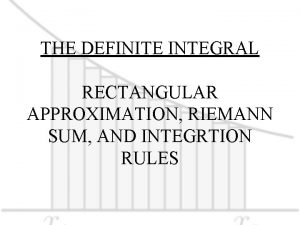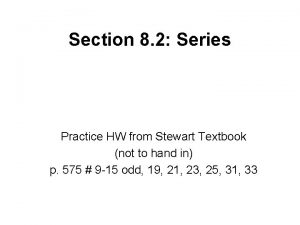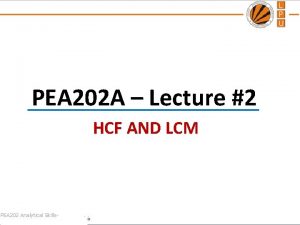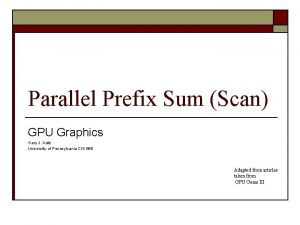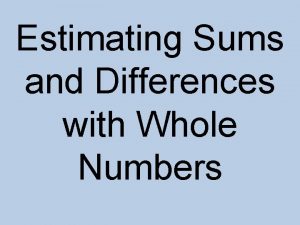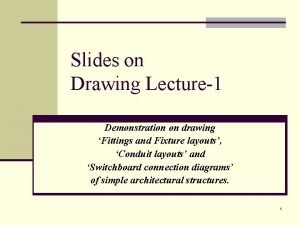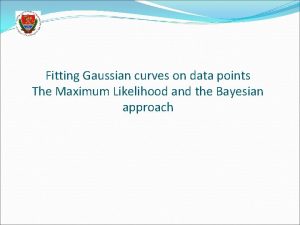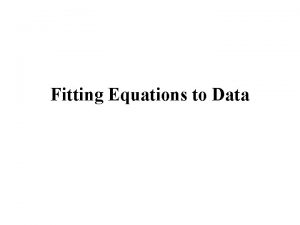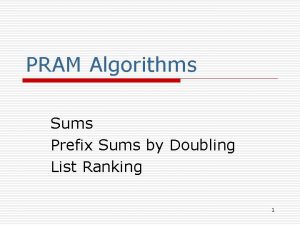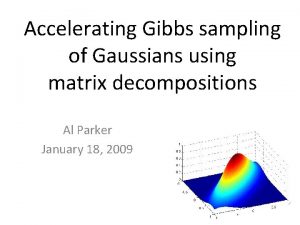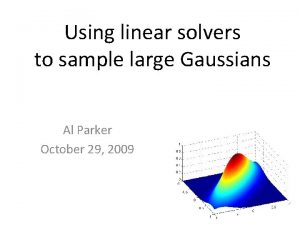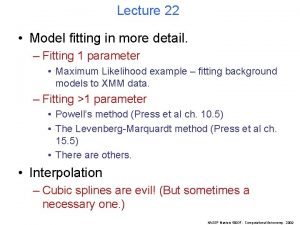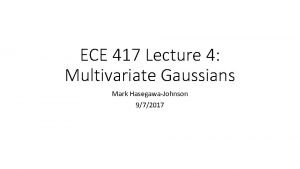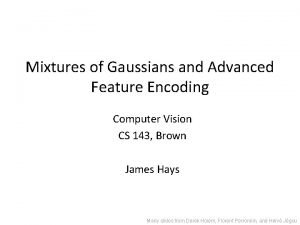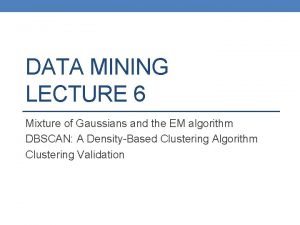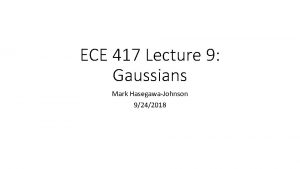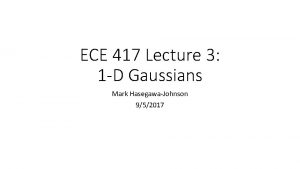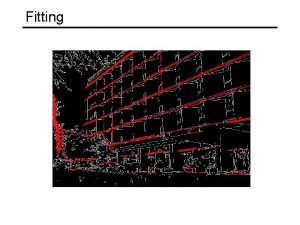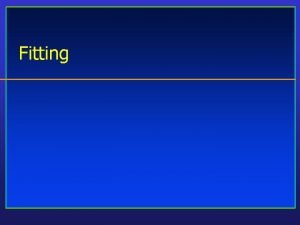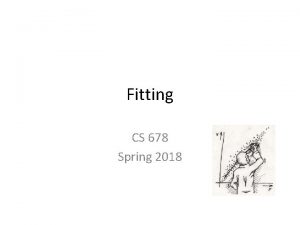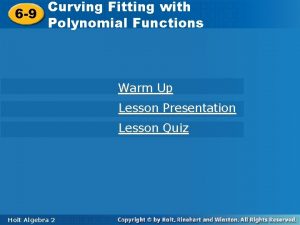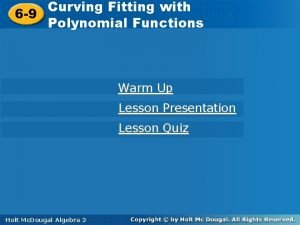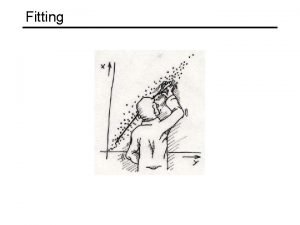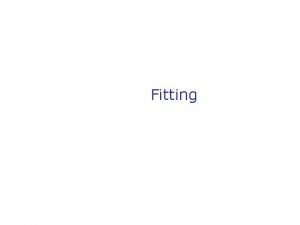Fitting Sums of Gaussians Can model fitting using

























- Slides: 25

Fitting Sums of Gaussians Can model fitting using sums of Gaussians provide an unbiased estimate of galaxy shear? Lisa Voigt & Sarah Bridle UCL

Talk Overview q Can modelling with sums of Gaussians provide an unbiased estimate of the ellipticity of galaxies with elliptical isophotes? q Investigate how the following factors affect the bias: • PSF convolution • Pixellisation • Number of Gaussians used to model the galaxy • Noise q Does the method provide an unbiased estimate of the ellipticity of galaxies with non-elliptical isophotes?

Simulating galaxies with elliptical isophotes

Modelling the galaxy with a single Gaussian: No PSF, small pixels Simulated galaxy Model Exponential e=0. 2 Gaussian q 15 pixels per FWHM along minor axis q Best-fit Gaussian to exponential found by minimising the Χ 2 between the images with respect to the 6 model parameters: x 0, y 0, e, phi, a, A Question: Is the measured galaxy ellipticity biased? (Bias = measured – true ellipticity)

Modelling the galaxy with a single Gaussian: No PSF, small pixels Simulated galaxy Model Exponential e=0. 2 Gaussian q 15 pixels per FWHM along minor axis q Best-fit Gaussian to exponential found by minimising the Χ 2 between the images with respect to the 6 model parameters: x 0, y 0, e, phi, a, A Answer: No - bias on ellipticity measured is < 0. 1 % (Bias = measured – true ellipticity)

Modelling the galaxy with a single Gaussian: Gaussian PSF, small pixels Simulated galaxy PSF = Gaussian True convolved image Model = Gaussian PSF = true PSF Best-fit model Question: Is the measured galaxy ellipticity biased?

Modelling the galaxy with a single Gaussian: Gaussian PSF, small pixels Simulated galaxy PSF = Gaussian True convolved image Model = Gaussian PSF = true PSF Best-fit model Answer: Yes! - bias on galaxy ellipticity measured > 1%

Modelling the galaxy with a single Gaussian: Gaussian PSF, small pixels Simulated galaxy PSF = Gaussian True convolved image Model = Gaussian PSF = true PSF Best-fit model Answer: Yes! - bias on galaxy ellipticity measured > 1% Need to model the galaxy with more than 1 Gaussian!

Modelling the galaxy with a single Gaussian: Including the effects of pixellisation • Pixellisation is a convolution followed by a sampling. • Convolution with the PSF dominates over convolution with the pixels if the PSF is larger than the pixel size.

Pixel integration • Modelling pixellated images requires pixel integration … takes a long time! • Use analytic approximation to pixel integration for a Gaussian image. • How good is this approximation? • Test by fitting a Gaussian to a Gaussian. • In simulated Gaussian use numerical pixel integration, with each pixel split into 50 x 50 sub-pixels. • Compare bias measured using analytic pixel integration in the model image with that measured using numerical pixel integration.

Pixel integration • Analytic approximation to pixel integration equivalent to ~10 x 10 sub-pixels. • To obtain a bias ~ 0. 1% need approximately 3 x 3 sub-pixels.

Modelling the galaxy with more than 1 Gaussian

Fitting the galaxy with multiple Gaussians: No PSF, small pixels Model = Gaussian Simulated galaxy = exponential Residuals 1 G 2 G q Tied parameters: x 0, y 0, e, phi q Free parameters: a, A 3 G

Fitting the galaxy with multiple Gaussians: No PSF, small pixels Residuals=Σ (Iitrue - Iimodel)2/(Σ Iitrue)2 x 100%

Fitting the galaxy with multiple Gaussians: Including the PSF

Χ 2 minimisation with multiple Gaussians Modelling the galaxy with 3 Gaussians requires minimising over 10 parameters … takes a long time. q Solution: image is linear in A, so solve for A’s analytically! q Removes thin line of degeneracy between A 1 and A 2. q

Adding in noise Galaxy size = 5 pixels/FWHM along minor axis

Bias as a function of ellipticity m~5 х10 -4 C~7 x 10 -6 q Includes PSF q Galaxy size = 3 pixels/FWHM q No noise bias = e 1 m – e 1 t = m e 1 t + c

Relationship between the bias on the ellipticity and the bias on shear • Express the relationship between the measured and observed e 1 using the equation: e 1 m = (1 + m) e 1 o + c where e 1 o ≈ e 1 i + γ 1 t • If we apply the same shear to all the galaxies in the sample then γ 1 t ≈ < e 1 o >galaxies + < e 1 i >galaxies • We estimate the shear, γ 1 m, by averaging over e 1 m, so γ 1 m = <e 1 m >galaxies = (1 + m) <e 1 o >galaxies + c γ 1 m ≈ (1 + m) γ 1 t + c

Simulating galaxies with non-elliptical isophotes

Fitting multiple Gaussians to galaxies with non-elliptical isophotes • Simulate galaxies with a sum of 2 Gaussians, each with the same flux, but different axis ratios. • First Gaussian represents the bulge: e fixed at 0. • Second Gaussian represents the disk: e varied up to 0. 4 • Perform ‘ring test’ to obtain bias on shear when galaxy is modelled with a sum of Gaussians. • Plot m and c as a function of disk ellipticity. Simulated galaxy PSF convolved image

Fitting multiple Gaussians to Galaxies with non-elliptical isophotes

Fitting multiple Gaussians to Galaxies with non-elliptical isophotes

Summary q Using Gaussians to model galaxies with elliptical isophotes: – Using 3 Gaussians to model the galaxy reduces the bias on the ellipticity measured to < 0. 1%. – The ellipticity measured from noisy images is also biased by less than 0. 1 %. – This method should do well on STEP 4 simulations! But… q A first look at modelling galaxies with non-elliptical isophotes suggests that using sums of Gaussians to measure shear may not be good enough for future surveys…

 Fourier transform of gaussian
Fourier transform of gaussian Sigma notation to integral
Sigma notation to integral Summation math
Summation math Partial sums addition
Partial sums addition Arithmetic sum formula
Arithmetic sum formula Fraction sums and differences
Fraction sums and differences Riemann sum trapezoid
Riemann sum trapezoid How to write riemann sums
How to write riemann sums What is distinguishable permutation meaning
What is distinguishable permutation meaning Clustering estimation with decimals
Clustering estimation with decimals Bidmas sums
Bidmas sums Geogebra exponential regression
Geogebra exponential regression Bidmas sums
Bidmas sums Science meets nature
Science meets nature 10 multiply sums
10 multiply sums How many morphemes are in the word farmer
How many morphemes are in the word farmer Midpoint riemann formula
Midpoint riemann formula Partial sums
Partial sums Hcf worksheet
Hcf worksheet Sums
Sums Multiplication sum
Multiplication sum Estimating sums and differences of whole numbers
Estimating sums and differences of whole numbers Fitting and fixture layout
Fitting and fixture layout Pilkington planar
Pilkington planar Gaussian curve fitting
Gaussian curve fitting Fitting equations to data
Fitting equations to data
